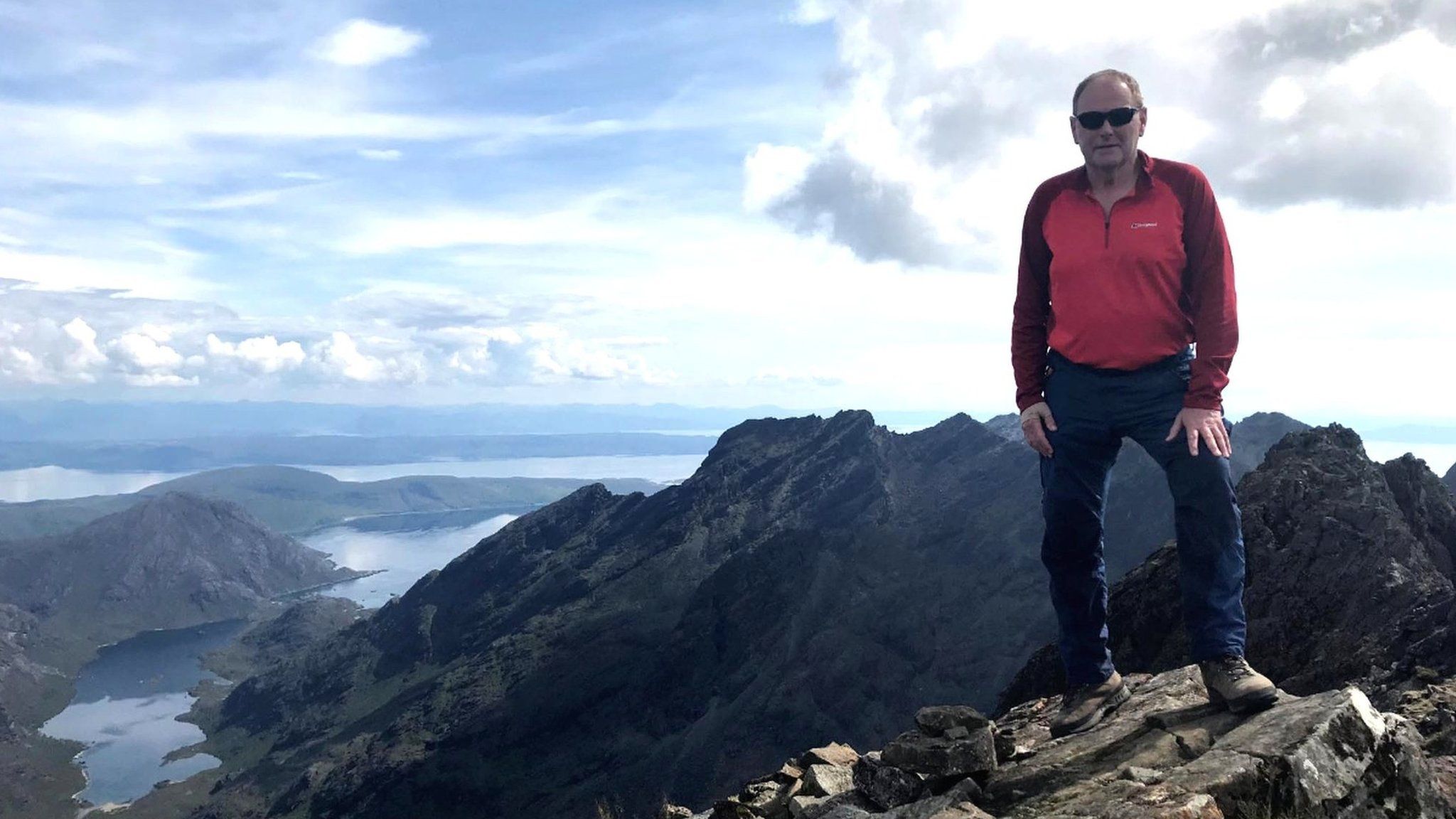The Munro who's finally bagged all Scotland's highest peaks
- Published

He gave his name to Scotland's Munros - but the mountaineer who was tasked with listing the country's highest peaks never got the chance to climb them all.
Sir Hugh Munro, who inspired the phenomenon known as "Munro bagging", died in 1919, at the age of 63.
It is thought he was three peaks short of completing his own list.
But now another Hugh Munro has completed the challenge of scaling all 282 Scottish mountains which are 3,000ft or higher.
On Saturday, the retired civil servant from Westhill, Aberdeenshire, reached the top of Slioch, north of Kinlochewe in Wester Ross.
In doing so he joined a list of about 6,500 "Munroists" who can boast of climbing all the peaks listed by his namesake, and thereby become eligible to join the Munro Society.
Before taking on his last Munro from the list, he told BBC Scotland: "I am Hugh William Munro, I have always been known as Willie, but for this one day of completing the Munros I'm going to use my Sunday name of Hugh Munro."
Mr Munro, from Westhill, Aberdeenshire, will be the only Hugh Munro on the list of successful "Munro baggers" maintained by the Scottish Mountaineering Club.
His achievement comes in the centenary year of Sir Hugh Munro's death.
Who was Sir Hugh Munro?
Hugh Munro, whose family were Scottish landowners, was born in London in 1856 and brought up at Lindertis near Kirriemuir in Angus.
While studying in Germany, he climbed in the Alps and continued his interest in climbing when he settled at the family estate in Scotland.
Sir Hugh was a founder and president of the Scottish Mountaineering Club which set him the task of listing all the country's hills of 3,000ft or more.
According to The Munro Society, he was the ideal choice because of his meticulous record-keeping, enthusiasm for work in the outdoors and fascination with mountain landscapes.
His table, comprising 283 separate mountains, was published in the club's journal in September 1891.
Over the years, the list has both grown and shrunk as new measurements have been taken - the most recent revision found Beinn a'Chlaidheimh in Fisherfield to be just under 3,000ft. The current total stands at 282.
Sir Hugh never managed to climb all the peaks on his original list.
Three summits are thought to have eluded him in 1919 when he died of pneumonia at the age of 63 while running a canteen for soldiers in France.
The latter day Hugh Munro fell in love with hillwalking when he was a boy of 14, and bagged his first Munro that same year.
"I went on a two-day trek through the Lairig Ghru," he recalled. "I can still remember everything about that - the smells, the sounds, the sights.
"It was in the spring and the snow was still hanging in the corries, reaching Rothiemurchus and that smell of Scots Pine.
"Later on that year I climbed Lochnagar and from then on I was hooked."
He kept a note of the peaks he climbed and later began to focus on the Munros.
"You start to create a plan. The last few years I have really organised my life around trips to do the Munros around Scotland. It's been fantastic - a bit of an obsession really."
Looking back at his years of Munro bagging, he would advise those wishing to follow in his footsteps to think carefully about the order they follow.
"A lot of people find they leave the remote ones, the more difficult ones for another day and suddenly that's all that's left," he said.
"The last couple of years have seen some very, very long days in the hills, some very long drives and some quite challenging scrambling in places like Skye."
He deliberately chose Slioch- standing at 3,218ft (981m) - for the final ascent of his challenge.
"I've got a photograph which I'm very fond of a long since deceased dog, standing at the head of Loch Maree with Slioch behind," he explained.
"It's a very iconic mountain and it's got a very good hotel at the end, the Kinlochewe Hotel where interestingly there's a photograph of Sir Hugh Munro and some contemporaries. We hope to recreate that photograph outside the Kinlochewe Hotel."
Knowing your Munros from your Corbetts - a guide to Scottish mountain terminology
- Munro - a Scottish mountain over 3,000ft (914.4m) with sufficient "separation" from neighbouring peaks
- Munro Top - a secondary peak over 3,000ft. There are 227 of them in addition to the 282 Munros
- Murdo - a summit over 3,000 ft with a "prominence" of at least 30m. All Murdos are Munro tops, but some tops fail to qualify as Murdos.
- Corbett - a separate mountain over 2,500 ft (762m)
- Graham - a separate mountain over 2,000ft (609.6m)
- Donald Top - elevations in the Scottish Lowlands over 2,000ft with a drop of at least 50ft (15.2m) between each elevation and any higher elevation
- Donald - the highest top at least 17 units (about a 30 minute walk) from the nearest one.
Mr Munro will be on BBC Radio Scotland's Out of Doors programme which is on from 06:30 to 08:00 on Saturday.
- Published19 March 2019